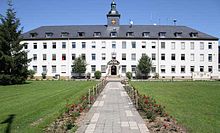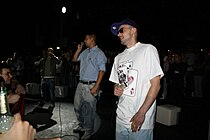Northwestern part of town (Schweinfurt)
|
Northwestern part of the city
Coordinates: 50 ° 2 ′ 59 ″ N , 10 ° 12 ′ 52 ″ E
|
|
|---|---|
| Height : | 229–255 m above sea level NN |
| Area : | 1.92 km² |
| Residents : | 3314 (Dec. 31, 2015) |
| Population density : | 1,726 inhabitants / km² |
| Postcodes : | 97421, 97424 |
| Area code : | 09721 |
|
Northwestern part of town (District 31)
|
|
|
Willy Sachs Stadium
before a 2013 pop concert |
|
The north-western district is a district of the independent city of Schweinfurt in the Bavarian administrative district of Lower Franconia . The north-western part of the city is listed as District 31 in the statistics of the city of Schweinfurt.
The name of the district comes from urban statistics, but is not in the public consciousness. Since it is functionally closely related to the musicians' quarter to the south, especially in the eastern area , it forms an urban planning unit with it and, moreover, streets in both parts of the city are named after composers. The north-western part of the city is linked to modern world history in many ways. It reflects the history of National Socialism , the US Army , the Cold War , the fall of the Iron Curtain , September 11th , to the refugee problem as a result of the civil war in Syria .
location
The north-western part of the city stretches along immediately north of the B 303 . It is identical to Niederwerrner Straße, a north-western arterial road to central and eastern Germany ( Autobahn 71 to Erfurt ) and to northern Germany ( Autobahn 7 to Kassel ).
The district is separated from the city center by Nikolaus-Hofmann-Straße. In the south it is bordered by Niederwerrner Strasse and the Musikerviertel , in the west by the municipal boundary to Niederwerrn , in the north by the previously uninhabited Pfannäcker corridor and the northern edge of the Alte Warte allotment garden and the Alten Wartweg.
history
The district was laid out along Niederwerrner Strasse in the 1920s and prior to all of the 1930s. It should extend even further in the direction of Niederwerrn (see Musikerviertel, history ). In contrast to the narrow, higher block perimeter development of the 1920s in the eastern part of the district along Niederwerrner Straße, the new urban planning of the 1930s is evident in the west , with lower block perimeter development and large, green inner courtyards, with uniform, dead straight, long house fronts and tree avenues.
The subsequent tank barracks from 1935/36, the later Ledward Barracks and the Willy Sachs Stadium from 1936 were built together with the rest of the district in the 1930s, which is also reminiscent of the Olympic pharmacy in Niederwerrner Strasse. This district, characteristic of Schweinfurt, reflects one of the most important epochs of modern local urban development , in which large-scale industry with its clinker buildings also emerged (see: Oberndorf ).
Social structure
After 2014
| Status December 31, 2014 |
Northwestern part of the city | The entire Schweinfurt area |
|---|---|---|
| German | 65.4% | 70.1% |
| Dual nationals | 15.5% | 16.1% |
| Foreigners | 19.1% | 13.2% |
The proportion of foreigners is well above the values for the entire city area. It should be noted that citizens with a migration background and a German passport are not included in the statistics.
The district experienced a fundamental social change. If there was an aging predominantly German population in the 1970s, many people with a migration background and single mothers moved in afterwards. The age group 0–34 years is represented above average with 40.4%, compared to the entire city area with 36.5%.
Until the withdrawal of the US armed forces in 2014, US citizens were added to the district, but they were not included in any German statistics. The actual population of the city was also unknown until then, as the American statistics only summarized the US citizens from the independent city of Schweinfurt and the district of Schweinfurt in one sum.
Until 2014
The district extends north along the 4 km long Niederwerrner Straße (see: Location ). After the Second World War it became the "main street" of the US Army Garrison Schweinfurt , with around 4,000 soldiers and over 7,000 civilians until the troop withdrawal in 2014. Barracks, American residential and business districts and American schools stretched on both sides of the street a further 2 km to Niederwerrner area. In the area of the street near the city center, on the sunny side (north side), a German-American promenade developed under the avenue trees, with guest gardens, ice cream parlors, pizzerias, pubs and nightspots. The city's first pizzeria , La Gondola , opened here in 1959 and is still unchanged today. With the departure of the Americans, the street lost its life and its special character.
Districts
Northwestern part of town (in the narrower sense)
See the history section
Carus Park
1935–1936 the Adolf Hitler barracks , better known under the popular name Panzerkaserne , was built for the 4th Panzer Regiment. After the American forces marched into Schweinfurt on April 11, 1945, the barracks were renamed Ledward Barracks in 1951. Since the US Army withdrew from the city in 2014, the international university campus i-Campus Schweinfurt has been built here. From 2015 until 2019, the city of Schweinfurt temporarily rented part of the Ledward barracks, which it had owned since the same year, to the Free State of Bavaria for a reception facility for refugees.
Willy Sachs Stadium
The stadium with a large adjoining sports park and tennis club was opened a month before the 1936 Olympic Games in Berlin . Hermann Göring and Heinrich Himmler , among others, were present at the inauguration . The grandstand was built in the Bauhaus style. In its time it was one of the largest sports parks in Germany and is still considered to be one of the most beautiful sports parks in Germany in its timeless modernity and also because of its large population of trees. (see also Schweinfurt, Willy Sachs Stadium )
It is the home of 1. FC Schweinfurt 05 , which has a stipulated first right of use for the stadium from the donor. From 1936 until the introduction of the Bundesliga in 1963, FC 05 played here in the top division and was last represented in the second division in the 2001/2002 season . Since 1999, large pop concerts with up to 22,000 visitors have been held in the Willy Sachs Stadium in summer . The Backstreet Boys , Die Toten Hosen , Sunrise Avenue and Herbert Grönemeyer have already been here .
Yorktown Village
Yorktown Village is a former US Army residential area that was built from 1986 to 1992. It was named after the Battle of Yorktown , or the place Yorktown (Virginia) . Two years after the US armed forces had withdrawn from Schweinfurt, the 68 semi-detached houses were raffled from 800 applicants in 2016, which attracted nationwide media coverage.
Kessler Field
The Kessler Field (12 ha) south of Yorktown Village is another former American area, with the former 1987/88 built high school , sports fields, a sports hall and a large bowling center .
On March 1, 2016, the building of the former high school was handed over by the city of Schweinfurt to the English-speaking International School Mainfranken (ISM), which had previously been based in Unterspiesheim , by means of a heritable building right contract , and classes began at the new location in autumn 2016. The Kessler Bowling Center, which once had 24 lanes, has been converted into a large next level therapy and training center.
In the north of Kessler Field, in the as yet undeveloped but already developed area immediately south of Yorktown Village, between California, Texas and Florida streets, apartment buildings are planned according to a master plan of the city.
Hainig
The Hainig (also: Am Hainig , place name: am Hainig ) is largely an industrial park, which also has residential developments in its northern and eastern peripheral locations. The Hainig was built from the 1980s and currently (2019) still has some vacant lots. The district is located in the far west of the northwestern part of the city and borders on the municipality of Niederwerrn , with which it has grown together completely. At the Hainig are u. a. the office of the IHK Würzburg-Schweinfurt , the fire station on the Hainig , with volunteer fire brigade and permanent guard and the outpatient rehabilitation center on the Hainig .
The Hainig was and still is partly the discotheque center of the city, with the two large discos, Rockfabrik and Megadrom , which were once directly opposite . The rock factory is still unchanged today. In place of the megadrome, there is now the smaller Club 360 Grad disco . A bowling arena also opened (see: Schweinfurt, Nightlife : Discotheques).
Culture
Churches
Economy and Infrastructure
Authorities
- Federal Office for Migration and Refugees
- Police station
Urban facilities
- Willy Sachs Stadium with an attached sports park
- fire Department
- Public utilities
- Omnibus depot
Associations
See also
Web links
- Video: SW-N TV: The north-western district from the air in June 2017 (4:41)
- Video: Drive through Niederwerrner Straße (0: 00–5: 00) in “City of Schweinfurt: A short tour through the city. April 2018 "(19:42)
- 360: Yorktown Village, Kesslerfield and Ledward Barracks shortly after the US Army left (5:09)
- Video: A Salute to Schweinfurt . History of the Army in Schweinfurt (3:00 am)
- Video: City of Schweinfurt: Schweinfurt says goodbye to the US Army (2:00)
Individual evidence
- ↑ measured using the BayernAtlas
- ^ City of Schweinfurt
- ^ City of Schweinfurt: Youth welfare plan / overview map of the statistical districts. Retrieved February 9, 2019 .
- ↑ a b Youth welfare plan of the city of Schweinfurt, structural description of districts 22 and 31
- ↑ a b c Information from the Federal Agency for Real Estate Tasks (BImA) in: History of the properties of the military site in Schweinfurt
- ↑ Population register-based
- ↑ a b youth welfare plan of the city of Schweinfurt
- ↑ Information from the Federal Agency for Real Estate Tasks (BImA). Retrieved July 2, 2018 .
- ^ TV Touring Schweinfurt: Impulse. The business magazine , October 19, 2016
- ^ Economy in Mainfranken, July 2012, p. 34
- ^ TV Touring Schweinfurt, March 17th, 2016
- ↑ Framework plan of the city of Schweinfurt for the State Garden Show 2026






